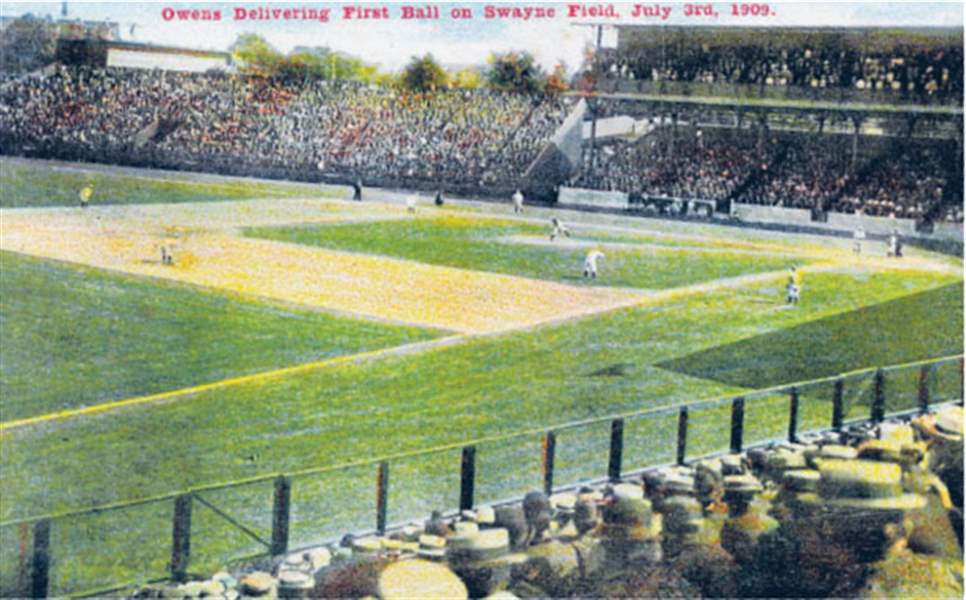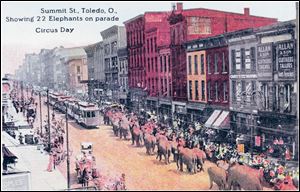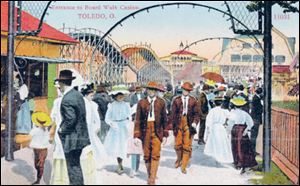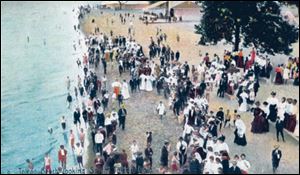
Hundreds of postcards from Toledo's past are in a new book
10/5/2008
A postcard commemorates the first pitch at Swayne Field in July, 1909.

To promote a circus, 22 elephants paraded down Summit Street, Toledo s shopping district, a century ago.
A century ago, few Toledoans had telephones in their homes, and that era was, of course, many decades before the Internet and e-mail.
But the city's residents communicated quite easily with friends and relatives across town, and across the country, by mailing postcards for postage of just a penny.
Those colorful postcards now cherished by collectors, and the focal point of a new coffee-table book portray the city's vibrancy and quality of life a hundred years ago.
Toledo's downtown had big department stores such as Milner's, Lamson Brothers, Tiedtke's, and the Lion Store. There were new, and grand, 'skyscrapers,' including the 17-story Nicholas Building at Madison Avenue and Huron Street (known for decades as the National Bank Building and later, until recently, Fifth Third Center).
Businesses of every sort flourished around town.

Lake Erie Park Casino was reached by a 1,500- foot boardwalk into Maumee Bay.
Toledoans also had many opportunities for fun. Among the biggest attractions were the Lake Erie Park Casino reached by a 1,500-foot boardwalk built on pilings our into Maumee Bay and Toledo Beach, a lakefront resort along the trolley line north of the state border, in Michigan.
Then, as now, Toledoans enjoyed watching their Mud Hens, and nearly a century ago, in the summer of 1909, baseball fans celebrated a great new venue, the Swayne Field ballpark. Naturally, the first pitch in the new park was captured on postcards.
Such was Toledo's fame that the city was chosen for the 42nd national convention (or 'Encampment' of the Grand Army of the Republic in September, 1908 a gathering of nearly 100,000 Civil War veterans and family members. Toledoans proudly mailed postcards commemorating the event.
'Postcards were once a primary means of communication, before everyone had telephones,' said Ken Levin, whose vast collection of Toledo postcards is showcased in the new book,
You Will Do Better in Toledo: From Frogtown to Glass City, published by The Blade.

A postcard commemorates the first pitch at Swayne Field in July, 1909.
'And inadvertently the pictures [on the postcards] created a valuable and almost unique history of the development of the city of Toledo.'
The $54.95 book will be available at area bookstores starting Wednesday, and will also be sold through The Blade. A book release and signing event is to be held tomorrow at 7 p.m. in the McMaster Center of the Toledo-Lucas County Public Library in downtown Toledo. Editors of the book are Sandy and John Husman, who also edited The Blade's three-volume Toledo: Our Life, Our Times, Our Town.
About 300 of Mr. Levin's collection of nearly 4,000 postcards appear in the book, but also included is a compact disc that displays 2,000 of the cards dating from 1893 to 1929.
Mr. Levin began collecting Toledo postcards more than 35 years ago, in the early 1970s, when he left his job as an Antioch College history teacher and started a second career as a commercial real-estate appraiser in Toledo.
'Crawling through all those old buildings kind of got me into Toledo history,' said Mr. Levin. 'I tried to give my clients a history of their buildings.'

Toledo Beach, a popular summer resort, was along the trolley line in Michigan.
He was fascinated by a postcard collection owned by the late William Gerwin, and for years he helped Mr. Gerwin by finding postcards at antique shops, flea markets, through the Internet, and by buying some from other collectors. In the 1980s he took over the collection of Mr. Gerwin, who died eight years ago at the age of 87.
Mr. Levin said postcards have been around since 1873 but picture postcards began during the 1893 World's Fair in Chicago, formally known as the Columbian Exposition to honor the 400th anniversary of Columbus discovering the new world. Coincidentally, one of the most popular exhibits at that fair was sponsored by Toledo's Libbey Glass.
After the World's Fair experiment, the government allowed 'private mailing cards' (including those with photographs) that could be mailed with a 1-cent stamp. 'From then on, it just went crazy,' said Mr. Levin, adding that billions of postcards were produced after that. 'The whole industry just grew up.' The postcard craze was aided by Eastman Kodak's innovation of roll film, with negatives the same size as postcards.
For years, the best-quality postcards were made in Germany and Italy, according to Mr. Levin, but most of their plants were destroyed in World War I, and so the quality declined after that.
Mr. Levin said his collection is 'priceless right now' and will eventually find its way to a museum, university, or other public institution. 'I'm definitely going to do the right thing,' he said. 'This collection is definitely a trust.' This [represents the golden age' of Toledo's contribution to world civilization.'
Contact Homer Brickey at: homerbrickey@theblade.comlor 419-724-6129.